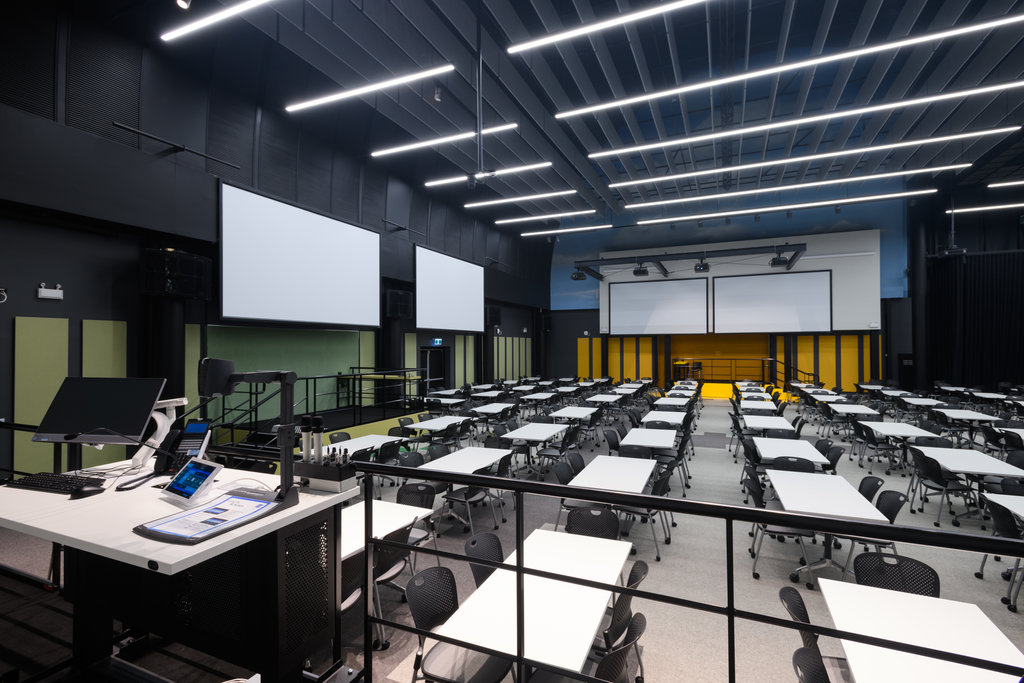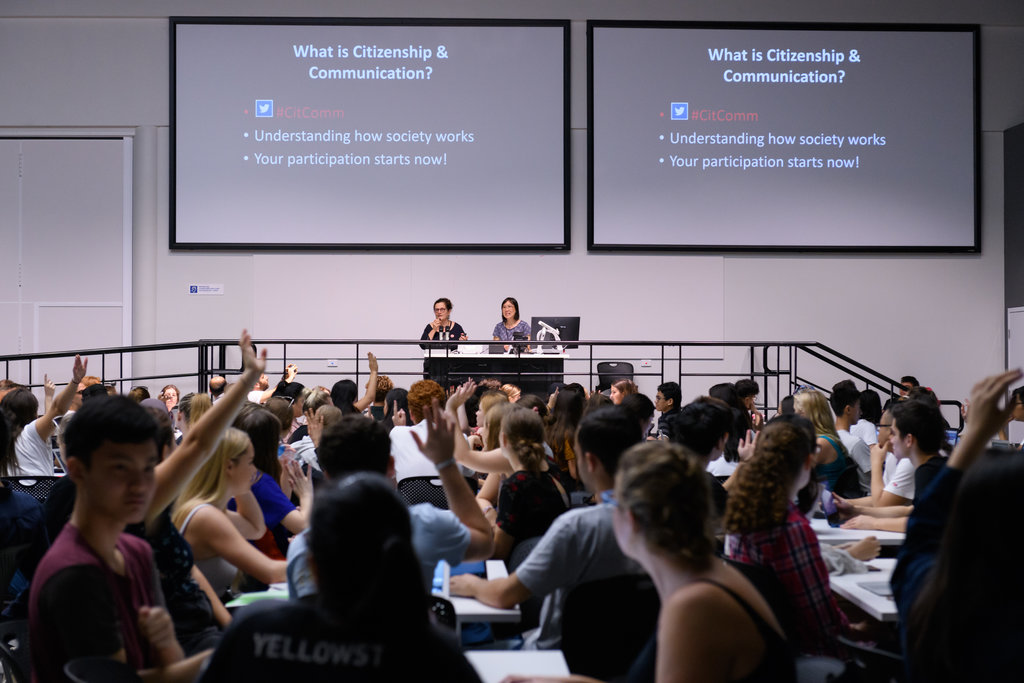UTS’s latest addition to the campus is now in action, with the high-tech 400-seat collaborative classroom down at Powerhouse hosting classes for marketing, life sciences, health, accounting, and communications. The flexible teaching space has been purpose-designed by academics, for academics.
Driven by the learning.futures approach to learning, the space was custom-designed to address the challenge: How can we run active and collaborative activities for large classes?
What will you find in the Powerhouse Collaborative Theatre?
- Multiple large projection screens that provide excellent sight-lines and an immersive experience.
- A main presenter platform with a lectern that includes state-of-the-art AV facilities, including lapel and radio microphones, dual-screen data projector controls and a built-in video camera to project whiteboard notes.
- Three additional colour-coded presenter stations that allow students or guest presenters to feed into classes and act as co-presenters. These stations feature a microphone and data input to the projector control
- Tables of five that allow for collaboration and small-group work between presentations.
- Mobile tables that can be joined to accommodate larger groups as needed.
- Colour-coding on the four walls, for easy navigation to group activities in different parts of the room.


Shirley Alexander explains the learning design
“It was a collaborative design between a team of UTS academics and the architects. Over many months of consultation, the architects presented their ideas at each stage to the academic team. And, drawing on their teaching experience and classroom needs, the academics would provide their feedback. It was truly an iterative approach.” But not every request could be accommodated. “Initially some of the academics had asked for platforms like those found at rock concerts, where the platform would rise out of the floor. That wasn’t exactly practical [laughs]. But we could compromise and the result was a design that incorporated four raised AV-equipped platforms at each of the colour-coded walls. That way the students could access the raised platforms as well as the academic, to act as co-presenters, showcase their work on the large screens, and split into smaller working groups within the large class,” says Shirley.
Jenna Price explains the learning experience
Jenna Price, Senior Lecturer in Journalism and part of the academic team who fed into the design process, says that the new space is a ‘dream classroom’ and she’ll be putting its features to good use – including those rock-star platforms.“Christina Ho (Senior Lecturer & Discipline Coordinator, Social and Political Sciences) and I teach a subject called Citizenship and Communication, and one of our activities is holding a mock preselection. It’s hilarious – we have four candidates competing and then students go towards their favourite candidate to cast their votes. It’s always been slightly chaotic in the traditional lecture halls but the new space is perfect,” says Jenna.
“We also have regular panel sessions with a range of prominent figures. In the past, screens have only been at the front, which is quite distancing for those at the back. This year, screens surround the students. They’ll be able to see and hear Race Discrimination Commissioner Tim Soutphommasane, Disability Discrimination Commissioner Alastair McEwin and Human Rights Commissioner Ed Santow broadcast to all the screens. Then students will be able to stand on one of the four stages to ask questions directly of these extraordinary people. So while the space allows students to work in groups, it also provides them with a better opportunity to ask questions,” she says.

What’s next? UTS Central’s collaborative theatre
Many of the features found in the Powerhouse Collaborative Theatre will also be used in the design of three large teaching spaces in UTS Central, which will take the collaborative design style to the next level. Shirley Alexander explains.
“The design for the Building 2 collaborative theatres will be even more innovative. There will be no obvious front to the room, but multiple group presentation stations. This is a clear move from ‘sage on the stage’ to more a ‘sage on the side’, enabling the academic to move between groups and encouraging a far more collaborative and student-focused experience for large class sizes. This new space will be the first one of its kind in the world. When we started out we sent two academics to Windsor in Canada. What they saw there was this beautiful collaborative theatre, but the academics were just giving lectures in the space. So Rob Jarman (Associate Dean of Teaching and Learning in FEIT) said – ‘well why don’t you design ours so there is no clear front to present a traditional lecture from. And we did.”
- While you might be used to a lectern in front of rows of chairs in a traditional lecture theatre, the UTS Central collaborative theatres will include multiple presenter spaces that allow academics to move around the room and engage with students as classes are happening.
- Flexible group tables will facilitate collaboration, while flexible data screens will also enhance group learning. During class presentations, all screens will be able to display the main presenter feed. During group-work, the screens can be split to display feeds from separate demonstrator points for up to eight groups, making collaborative screen-work easier to view and be involved in.
- Power points will be available around the room to charge students’ individual devices, and the spaces will be enhanced by daylight from large windows facing onto Broadway.
The Powerhouse collaborative classroom and the more traditional lecture theatre downstairs will be used to hold classes throughout 2018 and 2019. When UTS staff and students aren’t using the collaborative classroom it provides additional learning spaces for Powerhouse initiatives, partnerships and programs. The development of the new space significantly increases the capacity of both institutions to deliver exceptional formal and informal learning experiences and enables experimentation with new and innovative learning approaches.
Construction of UTS Central (Building 2) is due to be completed in 2019, which will open up more large teaching spaces on campus
The lingo
Students who have classes at the Powerhouse this session will see rooms marked with a ‘PH’ on their timetable. PH.01.03.101 indicates the Collaborative Theatre, while PH.01.02.100 is the downstairs lecture theatre that came online in 2017. Full details on access, opening times and finding your way to the Powerhouse are online here.


[…] It might be a big space, but this space has been carefully designed to encourage group collaboration (learn more about the design of the space at blog post ‘Academics feed into new collaborative classroom‘). […]